Abstract
1. Using a gastric barostat to quantify variations in gastric tone, we had previously demonstrated that food ingestion or intestinal nutrient perfusion induces gastric relaxation. These data suggested a basal tonic contraction of the stomach during fasting. 2. To determine the role of vagal input in maintaining fasting gastric tone, we prepared two chronic canine models, either isolating both cervical vagal trunks in a cutaneous tunnel or including the supradiaphragmatic vagi within an implanted cooling jacket. In the fasted conscious dogs, we then studied the effect, on gastric tone, of acute and reversible vagal blockade by cooling. 3. Cervical vagal cooling produced a reversible gastric relaxation and increased the heart rate. Supradiaphragmatic vagal cooling produced a similar gastric relaxation without the cardiac effect. 4. Adrenergic blockade did not change either the base-line gastric tone or the cooling-induced relaxation. Adrenaline decreased gastric tone, but vagal cooling still produced a significant relaxation. 5. Atropine alone or combined with adrenergic antagonists produced a gastric relaxation that was not further increased by vagal cooling. Bethanechol increased gastric tone, an effect unchanged by vagal cooling. 6. We conclude that gastric tone during fasting is maintained by a cholinergic input, which is vagally mediated at both the cervical and the supradiaphragmatic levels.
Full text
PDF

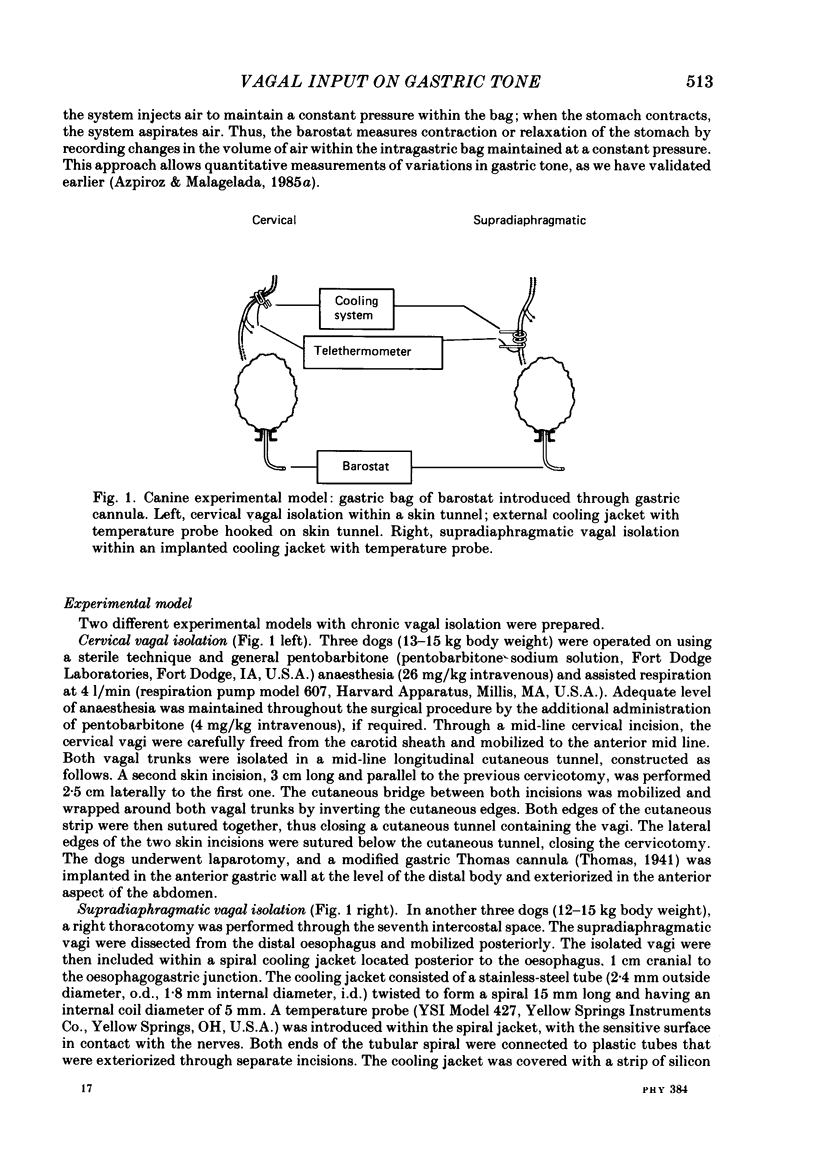
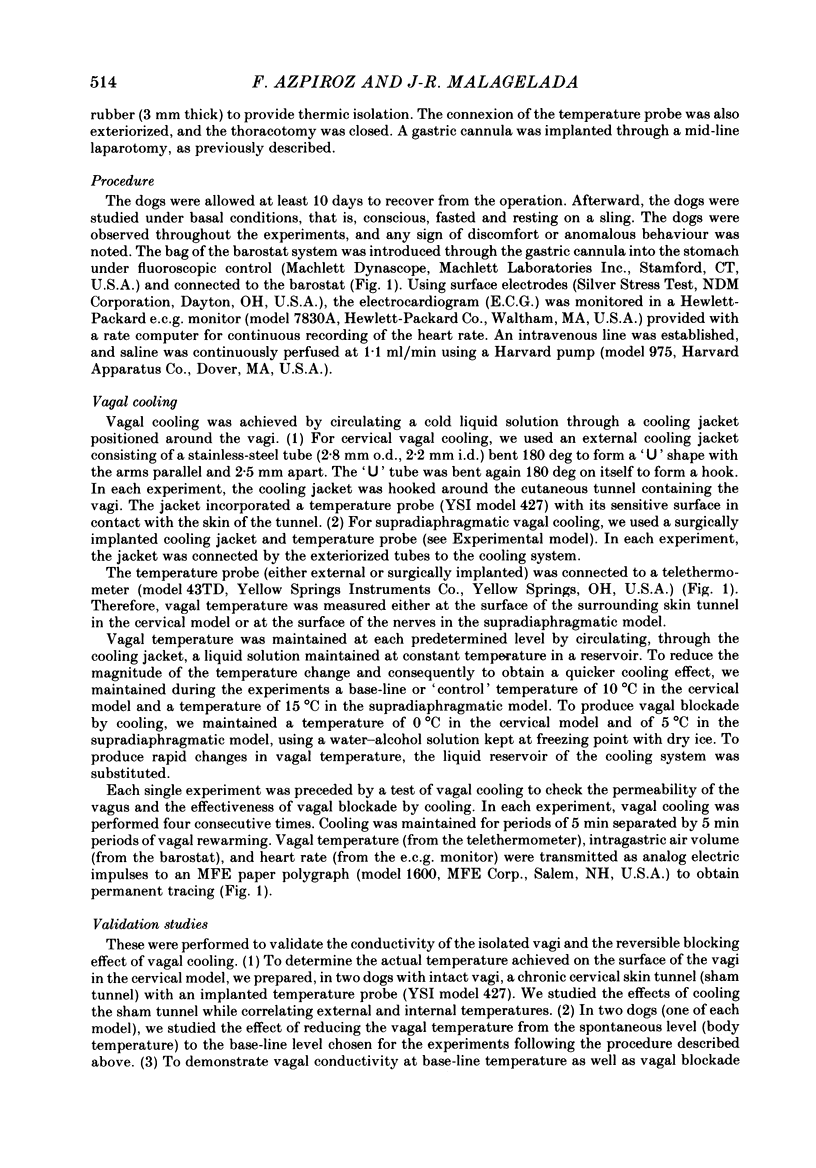

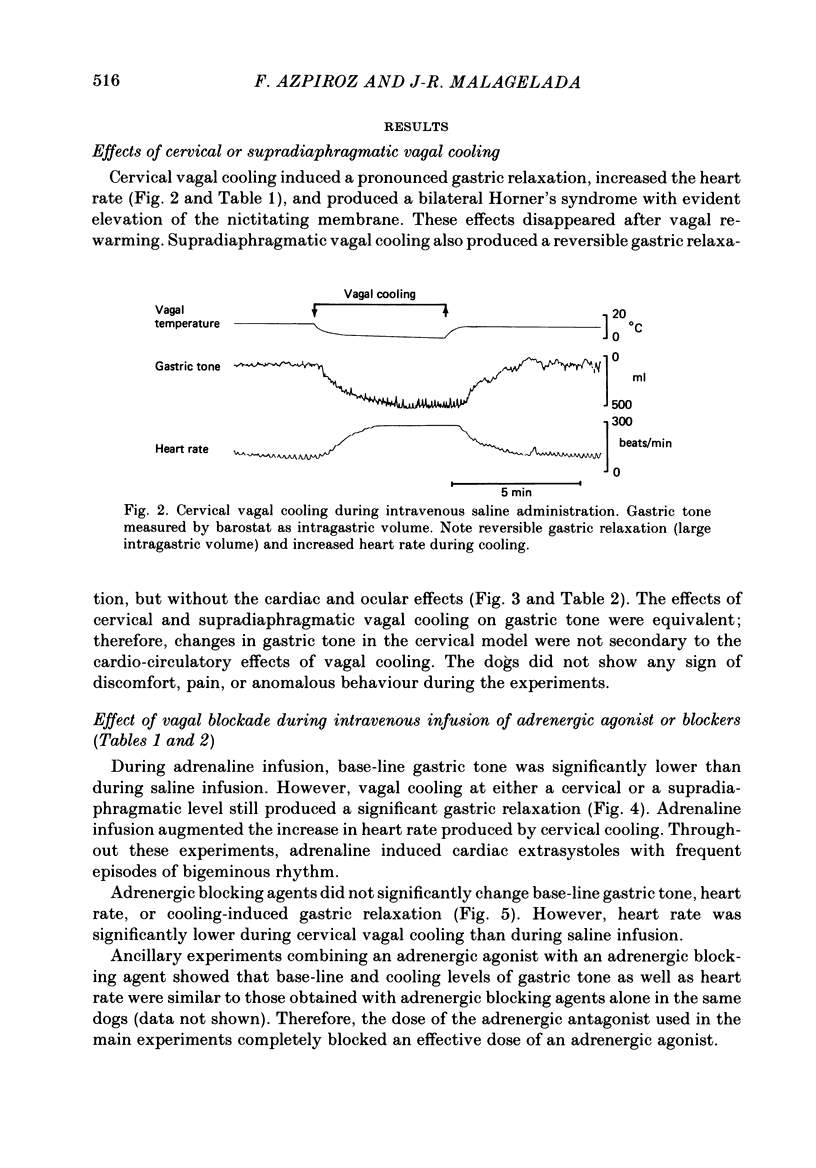
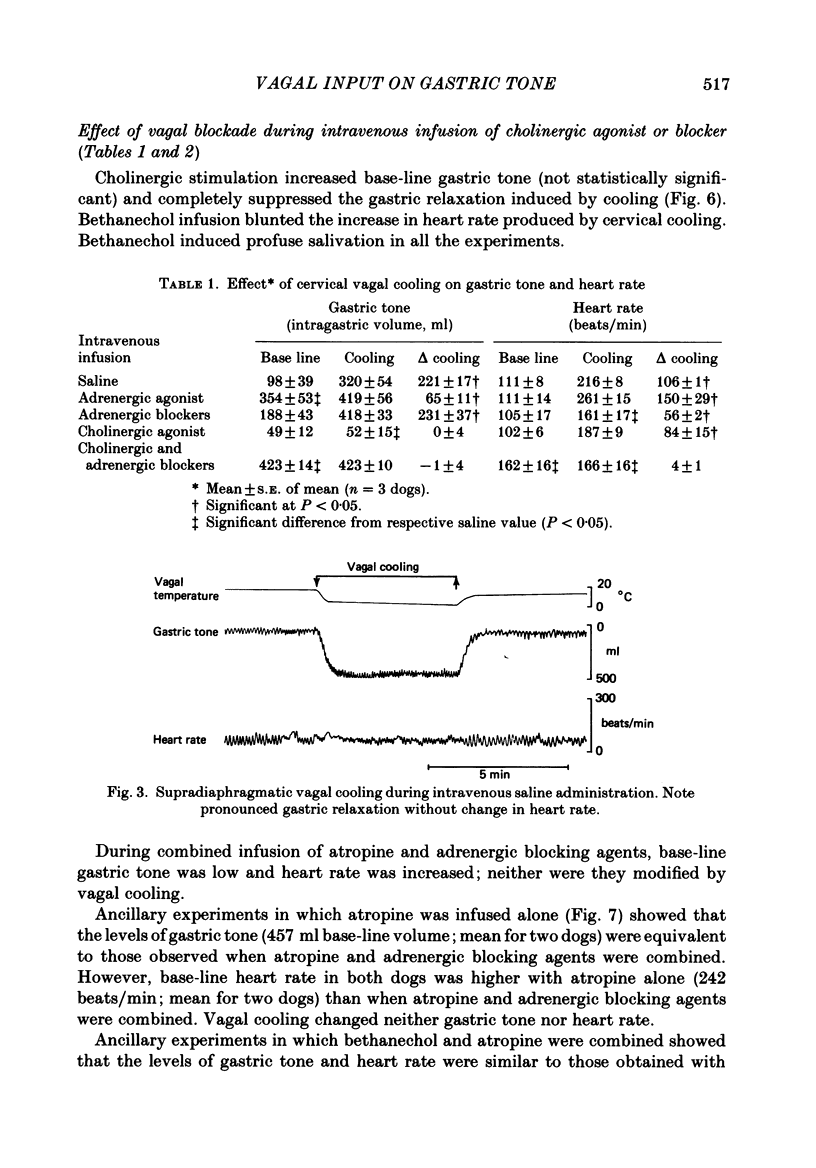
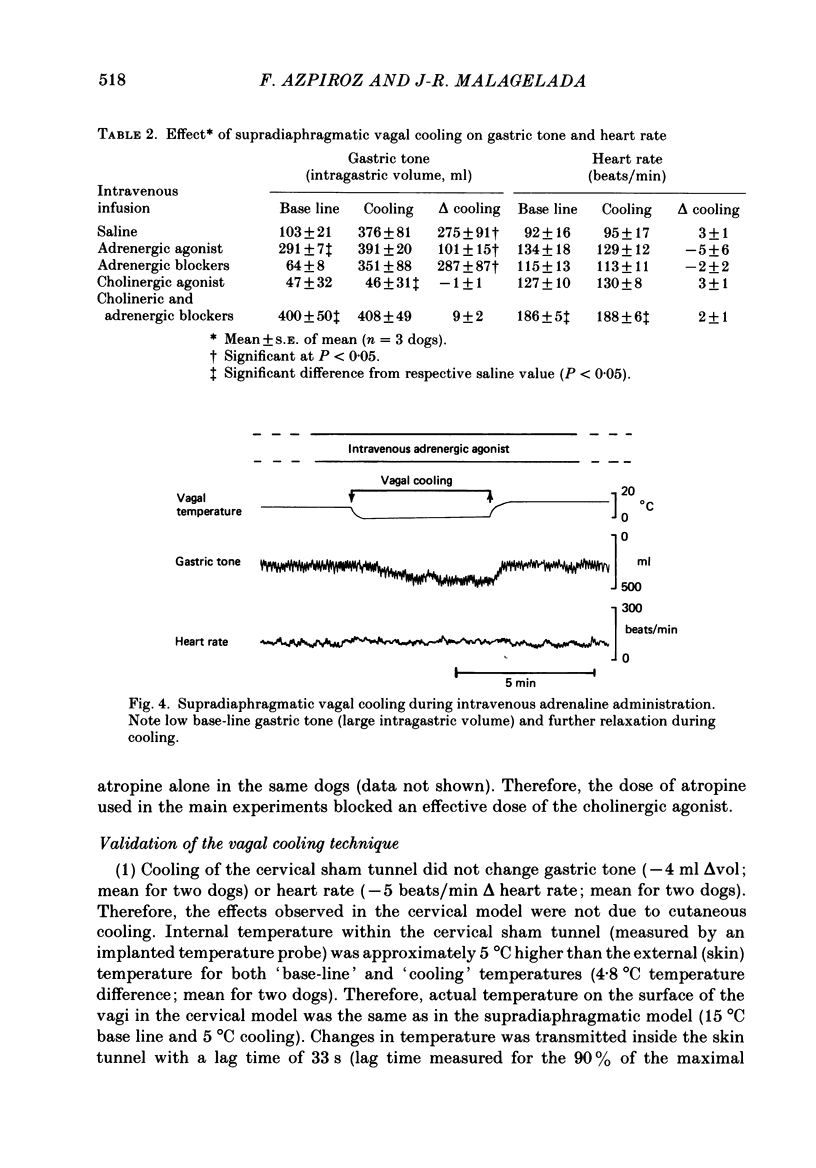
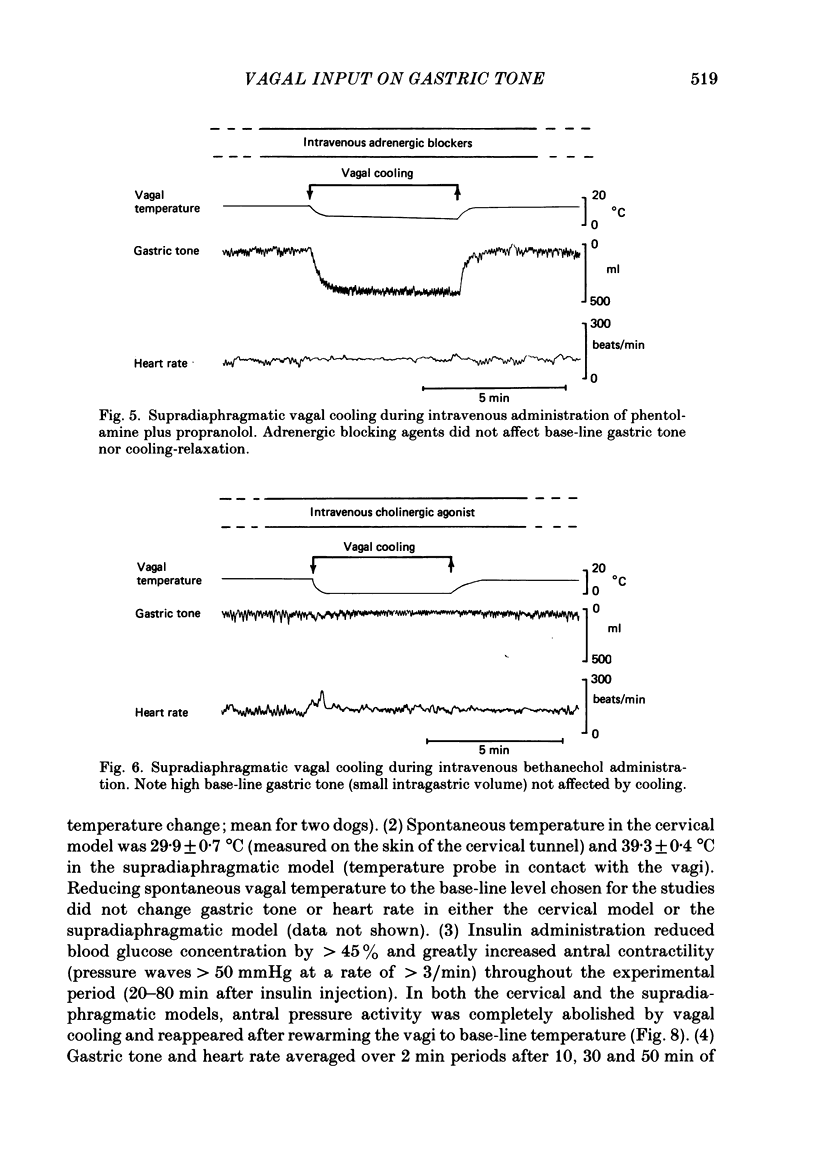


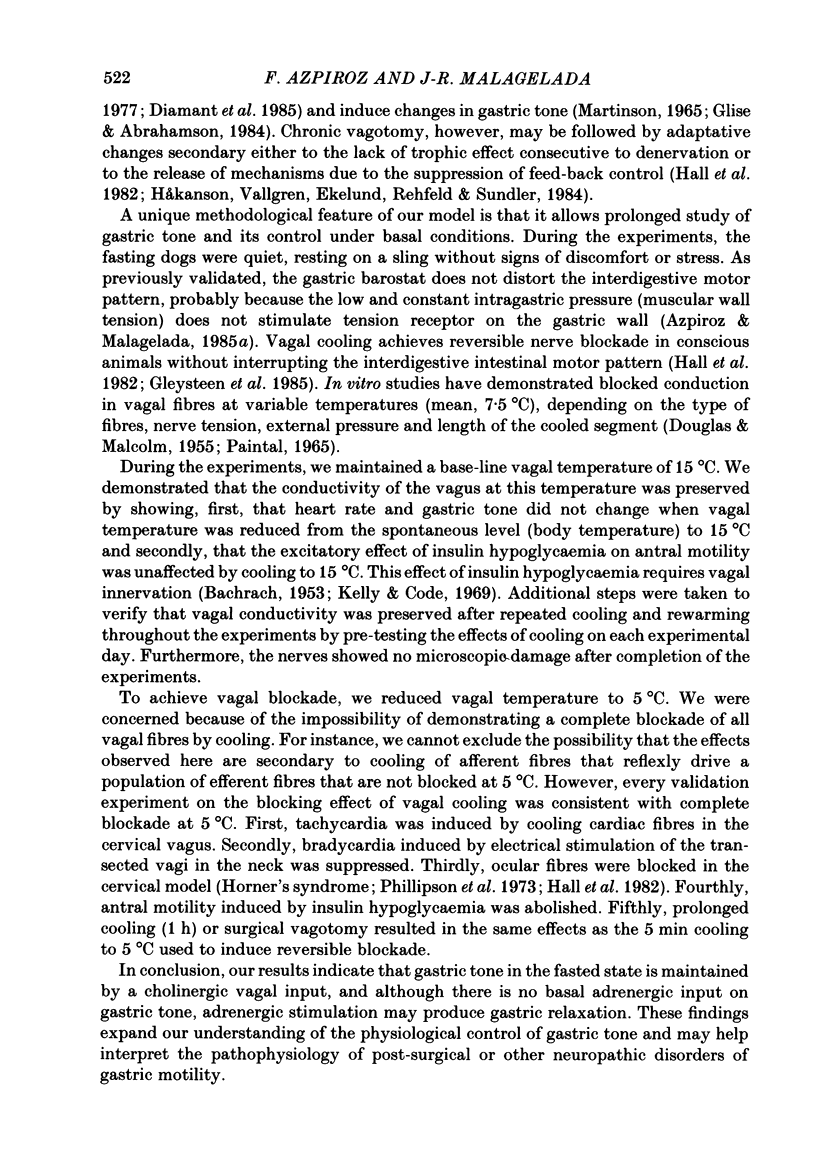

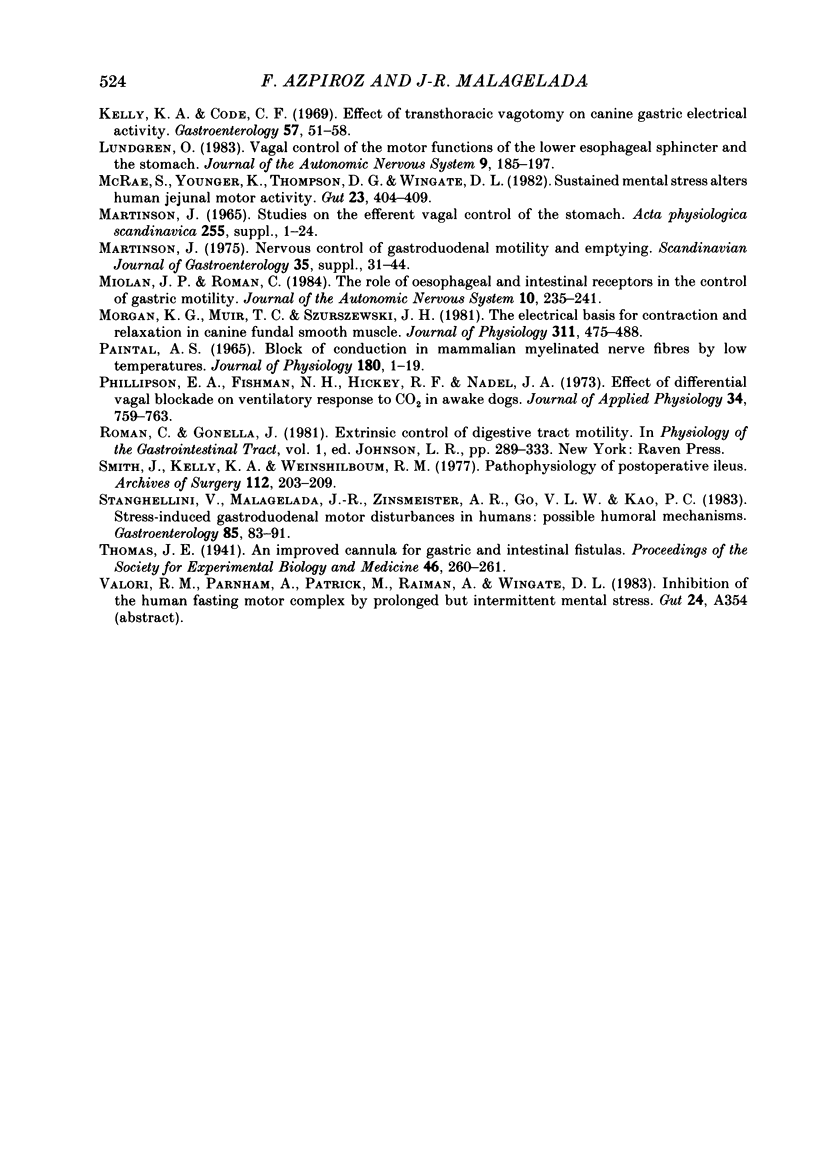
Images in this article
Selected References
These references are in PubMed. This may not be the complete list of references from this article.
- Ahlman B. H., Larson G. M., Bombeck C. T., Nyhus L. M. Origin of the adrenergic nerve fibers in the subdiaphragmatic vagus in the dog. Am J Surg. 1979 Jan;137(1):116–122. doi: 10.1016/0002-9610(79)90021-7. [DOI] [PubMed] [Google Scholar]
- Andrews P. L., Grundy D., Lawes I. N. The role of the vagus and splanchnic nerves in the regulation of intragastric pressure in the ferret. J Physiol. 1980 Oct;307:401–411. doi: 10.1113/jphysiol.1980.sp013442. [DOI] [PMC free article] [PubMed] [Google Scholar]
- Andrews P. L., Lawes I. N. Interactions between splanchnic and vagus nerves in the control of mean intragastric pressure in the ferret. J Physiol. 1984 Jun;351:473–490. doi: 10.1113/jphysiol.1984.sp015257. [DOI] [PMC free article] [PubMed] [Google Scholar]
- Andrews P. L., Lawes I. N. The role of vagal and intramural inhibitory reflexes in the regulation of intragastric pressure in the ferret. J Physiol. 1982 May;326:435–451. doi: 10.1113/jphysiol.1982.sp014204. [DOI] [PMC free article] [PubMed] [Google Scholar]
- Andrews P. L., Scratcherd T. The gastric motility patterns induced by direct and reflex excitation of the vagus nerves in the anaesthetized ferret. J Physiol. 1980 May;302:363–378. doi: 10.1113/jphysiol.1980.sp013248. [DOI] [PMC free article] [PubMed] [Google Scholar]
- Azpiroz F., Malagelada J. R. Intestinal control of gastric tone. Am J Physiol. 1985 Oct;249(4 Pt 1):G501–G509. doi: 10.1152/ajpgi.1985.249.4.G501. [DOI] [PubMed] [Google Scholar]
- Azpiroz F., Malagelada J. R. Physiological variations in canine gastric tone measured by an electronic barostat. Am J Physiol. 1985 Feb;248(2 Pt 1):G229–G237. doi: 10.1152/ajpgi.1985.248.2.G229. [DOI] [PubMed] [Google Scholar]
- Azpiroz F., Malagelada J. R. Pressure activity patterns in the canine proximal stomach: response to distension. Am J Physiol. 1984 Sep;247(3 Pt 1):G265–G272. doi: 10.1152/ajpgi.1984.247.3.G265. [DOI] [PubMed] [Google Scholar]
- BACHRACH W. H. Action of insulin hypoglycemia on motor and secretory functions of the digestive tract. Physiol Rev. 1953 Oct;33(4):566–592. doi: 10.1152/physrev.1953.33.4.566. [DOI] [PubMed] [Google Scholar]
- Code C. F., Marlett J. A. The interdigestive myo-electric complex of the stomach and small bowel of dogs. J Physiol. 1975 Mar;246(2):289–309. doi: 10.1113/jphysiol.1975.sp010891. [DOI] [PMC free article] [PubMed] [Google Scholar]
- DOUGLAS W. W., MALCOLM J. L. The effect of localized cooling on conduction in cat nerves. J Physiol. 1955 Oct 28;130(1):53–71. doi: 10.1113/jphysiol.1955.sp005392. [DOI] [PMC free article] [PubMed] [Google Scholar]
- Debas H. T., Yamagishi T., Dryburgh J. R. Motilin enhances gastric emptying of liquids in dogs. Gastroenterology. 1977 Oct;73(4 Pt 1):777–780. [PubMed] [Google Scholar]
- Gleysteen J. J., Sarna S. K., Myrvik A. L. Canine cyclic motor activity of stomach and small bowel: the vagus is not the governor. Gastroenterology. 1985 Jun;88(6):1926–1931. doi: 10.1016/0016-5085(85)90021-6. [DOI] [PubMed] [Google Scholar]
- Glise H., Abrahamsson H. Reflex inhibition of gastric motility pathophysiological aspects. Scand J Gastroenterol Suppl. 1984;89:77–82. [PubMed] [Google Scholar]
- HARPER A. A., KIDD C., SCRATCHERD T. Vago-vagal reflex effects on gastric and pancreatic secretion and gastrointestinal motility. J Physiol. 1959 Oct;148:417–436. doi: 10.1113/jphysiol.1959.sp006297. [DOI] [PMC free article] [PubMed] [Google Scholar]
- Hall K. E., El-Sharkawy T. Y., Diamant N. E. Vagal control of migrating motor complex in the dog. Am J Physiol. 1982 Oct;243(4):G276–G284. doi: 10.1152/ajpgi.1982.243.4.G276. [DOI] [PubMed] [Google Scholar]
- Håkanson R., Vallgren S., Ekelund M., Rehfeld J. F., Sundler F. The vagus exerts trophic control of the stomach in the rat. Gastroenterology. 1984 Jan;86(1):28–32. [PubMed] [Google Scholar]
- Jahnberg T. Gastric adaptive relaxation. Effects of vagal activation and vagotomy. An experimental study in dogs and in man. Scand J Gastroenterol Suppl. 1977;46:1–32. [PubMed] [Google Scholar]
- Jansson G. Extrinsic nervous control of gastric motility. An experimental study in the cat. Acta Physiol Scand Suppl. 1969;326:1–42. [PubMed] [Google Scholar]
- Kelly K. A., Code C. F. Effect of transthoracic vagotomy on canine gastric electrical activity. Gastroenterology. 1969 Jul;57(1):51–58. [PubMed] [Google Scholar]
- Lundgren O. Vagal control of the motor functions of the lower esophageal sphincter and the stomach. J Auton Nerv Syst. 1983 Oct;9(1):185–197. doi: 10.1016/0165-1838(83)90140-6. [DOI] [PubMed] [Google Scholar]
- Martinson J. Nervous control of gastroduodenal motility and emptying. Scand J Gastroenterol Suppl. 1975;35:31–44. [PubMed] [Google Scholar]
- Martinson J. Studies on the efferent vagal control of the stomach. Acta Physiol Scand Suppl. 1965;255:1–24. [PubMed] [Google Scholar]
- McRae S., Younger K., Thompson D. G., Wingate D. L. Sustained mental stress alters human jejunal motor activity. Gut. 1982 May;23(5):404–409. doi: 10.1136/gut.23.5.404. [DOI] [PMC free article] [PubMed] [Google Scholar]
- Miolan J. P., Roman C. The role of oesophageal and intestinal receptors in the control of gastric motility. J Auton Nerv Syst. 1984 May-Jun;10(3-4):235–241. doi: 10.1016/0165-1838(84)90018-3. [DOI] [PubMed] [Google Scholar]
- Morgan K. G., Muir T. C., Szurszewski J. H. The electrical basis for contraction and relaxation in canine fundal smooth muscle. J Physiol. 1981 Feb;311:475–488. doi: 10.1113/jphysiol.1981.sp013599. [DOI] [PMC free article] [PubMed] [Google Scholar]
- Paintal A. S. Block of conduction in mammalian myelinated nerve fibres by low temperatures. J Physiol. 1965 Sep;180(1):1–19. [PMC free article] [PubMed] [Google Scholar]
- Phillipson E. A., Fishman N. H., Hickey R. F., Nadel J. A. Effect of differential vagal blockade on ventilatory response to CO 2 in awake dogs. J Appl Physiol. 1973 Jun;34(6):759–763. doi: 10.1152/jappl.1973.34.6.759. [DOI] [PubMed] [Google Scholar]
- Smith J., Kelly K. A., Weinshilboum R. M. Pathophysiology of postoperative ileus. Arch Surg. 1977 Feb;112(2):203–209. doi: 10.1001/archsurg.1977.01370020097011. [DOI] [PubMed] [Google Scholar]
- Stanghellini V., Malagelada J. R., Zinsmeister A. R., Go V. L., Kao P. C. Stress-induced gastroduodenal motor disturbances in humans: possible humoral mechanisms. Gastroenterology. 1983 Jul;85(1):83–91. [PubMed] [Google Scholar]



